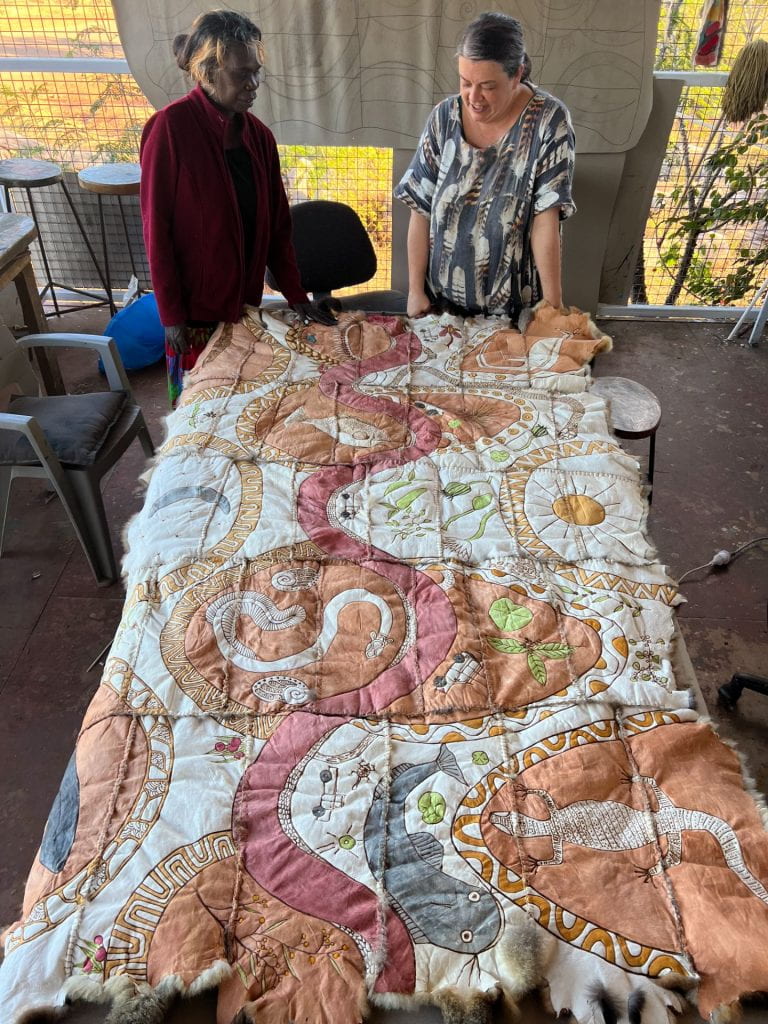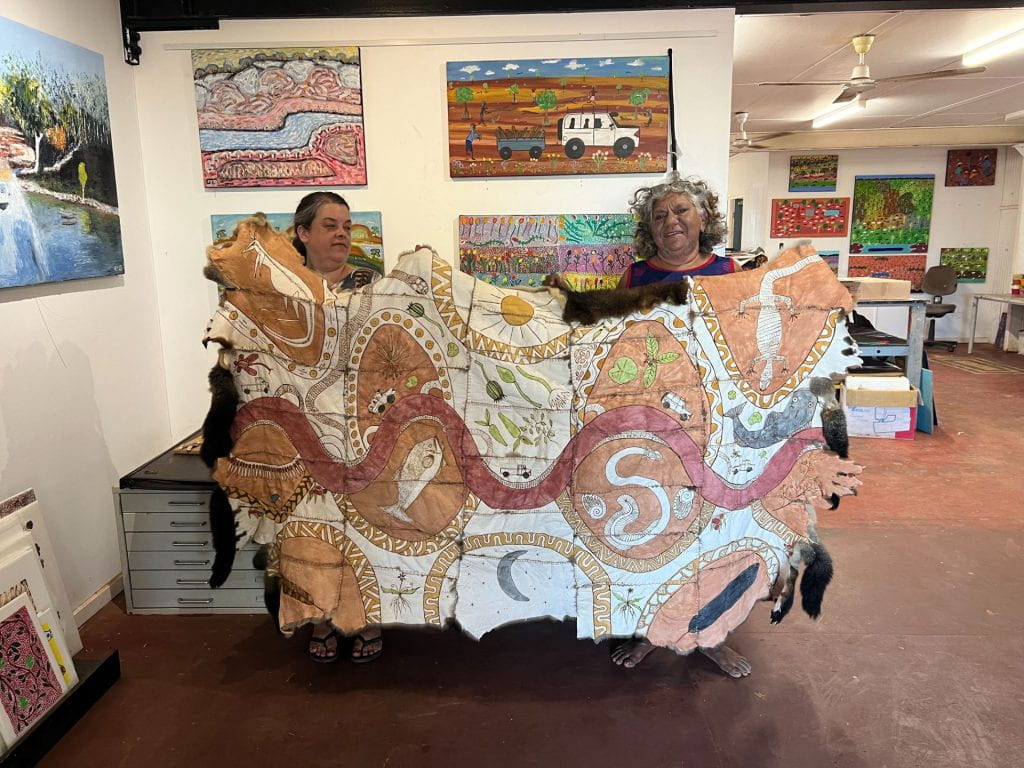Collections, Cloaks and Community Consent: Indigenous Cultural and Intellectual Property (ICIP)
Now that the Ngukurr field trip has ended, researchers and artists from Ngukurr and the southeast are processing the outcomes of the visit. This includes analysing how knowledge sharing about the project, inclusive of cultural information located in the Ngukurr digital archive, alongside the work of designing the stories that were marked on the possum skin cloak by artists from the north (Ngukurr) and the south (Vic/NSW), can be controlled and managed by the appropriate people. Finding ways to ensure that Indigenous Cultural and Intellectual Property (ICIP) is supported, is an ongoing process for the Living Archive project (see this link for more information about ICIP https://www.terrijanke.com.au/icip).
Kriol is the main language spoken in Ngukurr. There are, however, up to 10 language groups represented in Ngukurr – a result of the dispossession of people from their traditional lands from the late 19th to early 20th centuries (see this link to the Ngukurr Language Centre https://ngukurrlc.org.au/). Following the colonial invasion, many people from the region found their way onto the Roper River mission (the precursor to the current Ngukurr community). For many in Ngukurr today, English is their third or fourth language, which means that written information, such as consent or copyright forms, may not be the most appropriate way for obtaining permission to store or access their stories and/or cultural material in a digital database. While we were in Ngukurr, a range of alternative procedures for obtaining copyright/consent were set up. These are to ensure community can consider how they manage their ICIP with respect to the digitally archived material (both historical and contemporary) inclusive of the possum skin cloak we took to Ngukurr during our fieldwork (see post below) and the new designs that were marked on the cloak while it was in Ngukurr.
During our visit we were able to facilitate discussions about how material held in the Ngukurr digital archive (much of which currently resides physically in institutional collections) could be controlled as a resource by Ngukurr community representatives. This included consulting and collaborating with key Elders and Senior Knowledge Holders, who viewed a number of images from collections in galleries, libraries, archives and museums in Australia and overseas. A meeting took place at the Yugul Mangi Development Aboriginal Corporation where an agreement in the form of two letters were signed by community representatives (one that supported the Living Archive project at the University of Melbourne and the other from the director at Yugul Mangi). These letters endorsed the formation of the Yugul Mangi Living Archive Committee. Yugul Mangi comes from one of the local languages – Ngalakgan – and means ‘all together as one’. The Yugul Mangi Living Archive committee will now form the basis for ongoing consultation and collaboration about the Ngukurr digital archive.
One of the first ways of sharing the stories and images housed in the Ngukurr archive with the community occurred during a slide show evening. The ‘history photos’ were shown on a large screen in the recreation hall to about 50 young people. The screening created a lot of discussion, thanks to hosting of the event by Ngukurr Elder, Robin Rogers, who explained the photographs to the audience in Kriol and English. The audience also had the opportunity to engage closely with the initial mark-making on the possum skin cloak. The cloak was intriguing to many of members of the community, who wanted to know more about the markings/designs and were especially keen to touch and feel the soft possum pelts.
The marking of the possum skin cloak with cultural designs told stories that were relevant to each community, while also connecting people from the north and the south. The designs revealed how returning material from the archives to communities can support contemporary cultural knowledge and that storytelling through art-making is a means of ongoing knowledge exchange. This is a living archive. Making the Ngukurr digital collections available to the community, alongside the process of creating the designs through mark-making on the Ngukurr cloak, demonstrated how stories in the archive remain alive and connected to Country and kin. The cloak designs revealed each communities (i.e. Ngukurr and southeast Australian Aboriginal peoples’) connections to Country, their stories of activism and fighting for Aboriginal land rights, and of ecological knowledge – inclusive of seasonal plant use and the importance of maintaining healthy waterways. The process of marking the cloak reclaimed Indigenous knowledge from out of the ‘archive’ into the Ngukurr Arts Centre (https://ngukurrarts.com/), where the designing took place. The cloaks markings were the result of many hours of discussion between community Elders and Ngukurr artists, alongside the visiting southeast Aboriginal artists. All were involved in finding ways to continue knowledge exchange about their respective Country(s) and culture.
This twofold process of disseminating information about the digitised collections in the Ngukurr archive and the collaborations between Ngukurr and southeast Australian Aboriginal artists, simultaneously reinforced knowledge about their respective cultural practices and connections to Country, through the sharing of stories and creating of designs on a possum skin cloak. This collaborative approach also revealed the importance of supporting communities to maintain ongoing control of their cultural information/cultural heritage. The Living Archive project is setting in place processes, such as the Yugul Mangi Living Archive committee, that will ensure the Ngukurr community are able to manage their Indigenous Cultural and Intellectual Property (ICIP), including access and dissemination of historical and contemporary material located in the Ngukurr digital archive, as well as using this knowledge for creative practices. This approach includes supporting First Nations people involved in the Living Archive project (inclusive of those from the north and the south), with a means of controlling how their knowledge is used within their communities and how it may be shared more broadly. This is an ongoing process, which aims to provide First Nations peoples with the opportunity to determine how their culture and knowledge remains a living entity, rather than one that is located on the shelves and in the boxes of collecting institutions.
Written by Fran Edmonds
 Robin Rogers (Ngukurr), discussing people in an old photograph of Ngukurr (c. 1940s) during the slide show evening – June 2023.
Robin Rogers (Ngukurr), discussing people in an old photograph of Ngukurr (c. 1940s) during the slide show evening – June 2023.
 Daphne Daniels (Ngukurr) and Kerri Clarke (Boon Wurrung) admiring the almost finished cloak on the Arts Centre verandah – June 2023.
Daphne Daniels (Ngukurr) and Kerri Clarke (Boon Wurrung) admiring the almost finished cloak on the Arts Centre verandah – June 2023.
 Kerri Clarke and Karen Rogers (Ngukurr) – revealing the final cloak in the Ngukurr Arts Centre – June 2023 (current Ngukurr works on canvas are displayed behind the artists).
Kerri Clarke and Karen Rogers (Ngukurr) – revealing the final cloak in the Ngukurr Arts Centre – June 2023 (current Ngukurr works on canvas are displayed behind the artists).
Categories